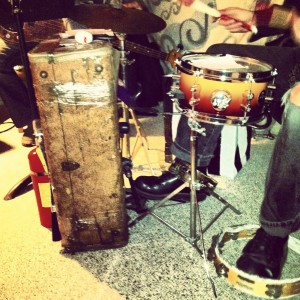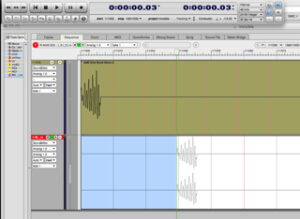
The Singles Series: “Invisible” – Rough Drum Ideas
I emailed him, “play the drums like on Matthew Sweet’s ‘Girlfriend’ or ‘Rhiannon’ from ‘Rumours,’ or both simultaneously.” Then, night fell.
The next morning John Fields, producer of two Wisely albums (“She” and “Turbosherbet“) sent me his big messy test pass of drums. Suddenly, the arrangement for “Invisible,” co-written with pal Cliff Hillis, leaps off the starting line.
Last week I had cut an acoustic guitar and lead vocal for John to drum to. The vocal was pitchy so I tuned it up in Autotune (I admit it).
John’s stereo mp3 mix of his drum ideas were ripe for a quick chop edit, from which I pasted together a rough take of my favorite moments. Kick drums and cymbal crashes were unceremoniously deleted, creating audible edit points. “But, it’s OK. We’re just spit balling here,” said Saul on ‘Breaking Bad’.
Leave it to John to always hit me with an illuminating idea, whether he’s playing drums, mandolin, accordion, bass or whatever. He’s a master of abandon. There’s no better time in a studio than watching him lay down a first pass at anything––an electric bass part particularly.
And don’t fence him in with rules, let him overplay and have fun. The economical performances that the song will ultimately need will come soon. He’s a pro. In the meantime, gather all his wild-eyed ideas while you can. He might dismiss them later. And because the guy records at such loud volume, you’ll have to yell at him when you like something. Then, force him to keep your favorites in the mix for the final take.
Here’s a snippet of a song called “Marrakech” that he whipped off for me last year.
For “Invisible” John’s drum performance started and stopped a lot––as he sought out different feels. This brought out the song’s comfort with scene changes. There’s many sections to “Invisible”, including a decelerando and then a long slow accelerando across 24 bars of coda, not to mention three full verses, and many long vamps––all waggling across a long five-plus minute track.
For longer songs, the trick to avoiding listener fatigue is to add detail to the arrangement. John’s drums pointed towards such a “duration solution.”
+ + + + +
Last week’s post contained a songwriting demo for “Invisible”. Cliff and I spent two sessions in September and December 2012 hammering the composition into place. We sculpted every stanza and musical motif a dozen times over, trying to get the song into a coherent emotional space, making it broad, yet throwing in specific names and places that meant something to us.
You moved to Manhattan
Like a moth toward light
The bit about the moth is stolen from an obscure songwriter hero of mine named Jackie Lomax. Check him out Beatle freaks.
Anyway, maybe I’ll get brave next week and post some of our lyric junkyard––lines that didn’t make the final cut.
We wrestled with choosing a heroic theme “We’re Invincible” rather than an arch theme “We’re Invisible”. The latter won out, though both sang equally well with the same melody. The heroic approach kept feeling too earnest and lacking in depth.
The bridge took a ton of time to write, going through at least twenty chordal permutations. It’s possible we over-thought it, because ultimately what we decided upon is complex—–a quality that dependably alienates a lot of people. Here’s the chord progression of the bridge:
| Gmj7 | Gmj7 | A- A-mj7 | A-7 A-6 | Fmj7 | C/G | Esus4 | E |
| D- | D- | C7 | C7 | Fmj7 | Fmj7 | Asus4 | A |
You might notice around that Esus4 that it’s easy to start singing “California Dreamin.”
Composing the bridge illustrated how wonderful it is when your mind’s ear hears something specific, but your fingers don’t yet know how to play it on guitar or keys. This is the best part of songwriting: figuring out what your subconscious wants to hear.
Once a song’s perfect–—when it satisfies all your emotional needs, it’s a great day to be alive. And it’s that magic moment that gives music its bigness.
Anyway, listen to the new track (the video at the top of the page). Leave comments and criticisms!!! Get mean. I’ll love it. In fact, for the next post, I’ll enumerate my own misgivings about the song. We’ll kick the shit out of it together.

Identical audio, one full-resolution file, the other an mp3. Three hundredths of a second buffer (in blue) is added to the beginning of MP3 files.
Click to see the entire collection of “Singles Series” blog posts.
This post’s spotify playlist: